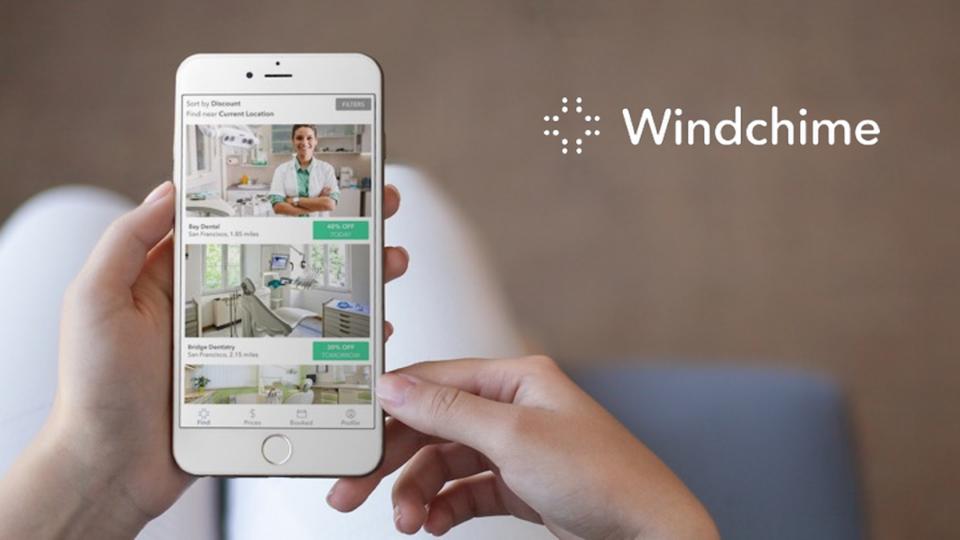UPDATE: Windchime was unable to raise their target minimum of $500k on SeedInvest, so the investment is canceled. Such a shame, I think this company would have done well.
It’s the Airbnb of dentist appointments—when patients cancel their appointments short-notice, Windchime helps to fill that in by providing a discount to someone else to fill it. Would be a win-win for all parties, except insurance companies (in a certain perspective.) Clients get wider access to dentists, rewards for showing up, and cheaper prices. Doctor salvage value from sudden cancellations while also increasing volume of patients and lead generation for new clients. Not to mention, dentists don’t have much bandwidth to run a digital marketing agency (Facebook Ads? Google Ads?) and can eliminate a huge secretary hire through smart self-serve booking software (Calendly.com.)
All this leads to more “activity” in dentistry: clients with more regular and preventative care, doctors with more business, only insurance companies lose with patients who can use their insurance more easily. That being said, dental insurance companies are price setters and can easily increase the price if usage meaningfully goes up, implying Windchime has become an industry influencer. First dentistry, then physical therapy, chiropractic treatments, and other “nice-to-have” health professionals.
Deal
https://www.seedinvest.com/windchime.health/seed
Minimum: $200 Crowd Note, Aug 2018
Decision
Yes.
Why investing?
- This is fundamentally a excess-capacity marketplace play, just like Airbnb, Uber, and even virtualization. In addition, I know this problem exists as I watched my dentists through the years switch office space, hire a secretary/scheduler, and move more into old age. I myself hate calling to make appointments and would love a Calend.ly solution to this problem. Then it could sync to my google Calendar just like everything else in my life. I’m a young professional, and as a member of that market, see the switch to this being inevitable. In fact, I’m not even sure why scheduling an annual check up with my physician isn’t like this. Coordination costs are definitely a big factor of why I use health services less than I would.
- In addition, there are even more system wins for a company like Windchime to consolidate marketing dollars for dentists in an organized fashion. Using scalable software and marketing (does it make sense for every dentist to have a digital marketer on their team? Obviously not.) to drive costs lower, Windchime may even be able to compete against “paper” based systems, which other CRMs, Mailchimps, etc. have proven to drive efficiency up. Leapfrogging at its finest.
- One of the last questions even asked if this product would make sense for chiropractors, physical therapists, etc. This seems like a natural in. In addition, the CEO did a thorough job answering questions in the Q&A section.
What the risks are
- Willingness to pay for SaaS by dentists. And same thing for doctors. It’s surprising that an insurance company would not be developing and distributing this SaaS to their dentists, though the insurance’s incentives may actually be to reduce actual visits as much as possible so they can keep as much of the premium to themselves. Back to dentists as decision makers, not sure how much software purchasing this group is used to. That being said, if the network can prove itself very quickly and drive net increased revenue, $3000/yr for 10% boost in business seems like a slam dunk.
- Lots of the wording in the SeedInvest page talks about acquiring users who are not insured. Certainly, with “special deal” discounts you will get more patients in the door and cause lead generation, but this doesn’t seem like a particularly attractive market to focus on, as becoming uninsured probably demonstrates a lower income bracket or decreased urgency for this type of service.
- Are there enough dentists to make money off of the SaaS model? The answer is probably “not really,” so the next step would then be getting some kind of affiliate deal or commission share once a doctor recoups their cost. Once Windchime is large enough and needs less of the cash flow management up front, they could even drive customers to a dentist without the monthly subscription fee but with a high revenue percentage (30% like on app stores.)
What has to go right for the startup to return money on investment
- Quarter over Quarter Growth (2018)
- Dental Practices:
- Practices Interested: 18 –> 65
- Practices in the Funnel: 10 –> 45
- Practices Signed: 4 –> 24
- Consumers:
- Downloads: 224 –> 2024
- Registered Users: 113 –> 680
- Transactions: 4 –> 25
- Dental Practices:
- Per the CEO’s response:
“We’ve got some more detailed information in our deck but a snapshot would be that our goal is to get to 750 practices in 2019, which would give us a revenue of 1.5M. We will be cash flow positive at about 375 practices.Our goal is to get the install rate within a practice’s existing patient population up to 20% (the average practice has about 1500 patients), which gives us about 225,000 users by the end of 2019.For new users, based on our CPA during the pilot and our budget from out minimum funding scenario, we believe we can get to between 2000-3000 new users per month through the marketplace.An important thing to note though is that for Windchime to more than pay for itself, a member practice (our source of revenue) would need to fill only 1 or 2 open appointments a month.” - Begin collecting revenue from the dentists and find that they are getting increased business to keep the scheduling around. Increased activity actually makes people redeem their benefits more. Rewards work like the loyalty rewards at small shops and actually get industry wide visits to increase by a non trivial percent.
Updates
Windchime was unable to raise their target minimum of $500k on SeedInvest, so the investment is canceled. Such a shame, I think this company would have done well.

